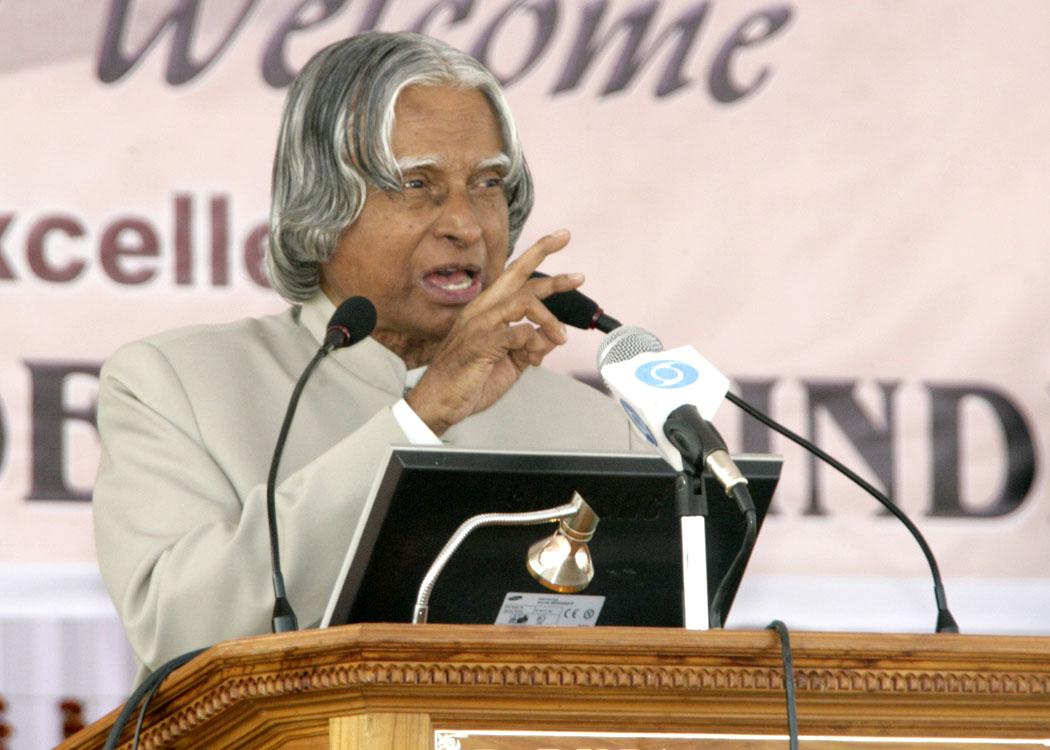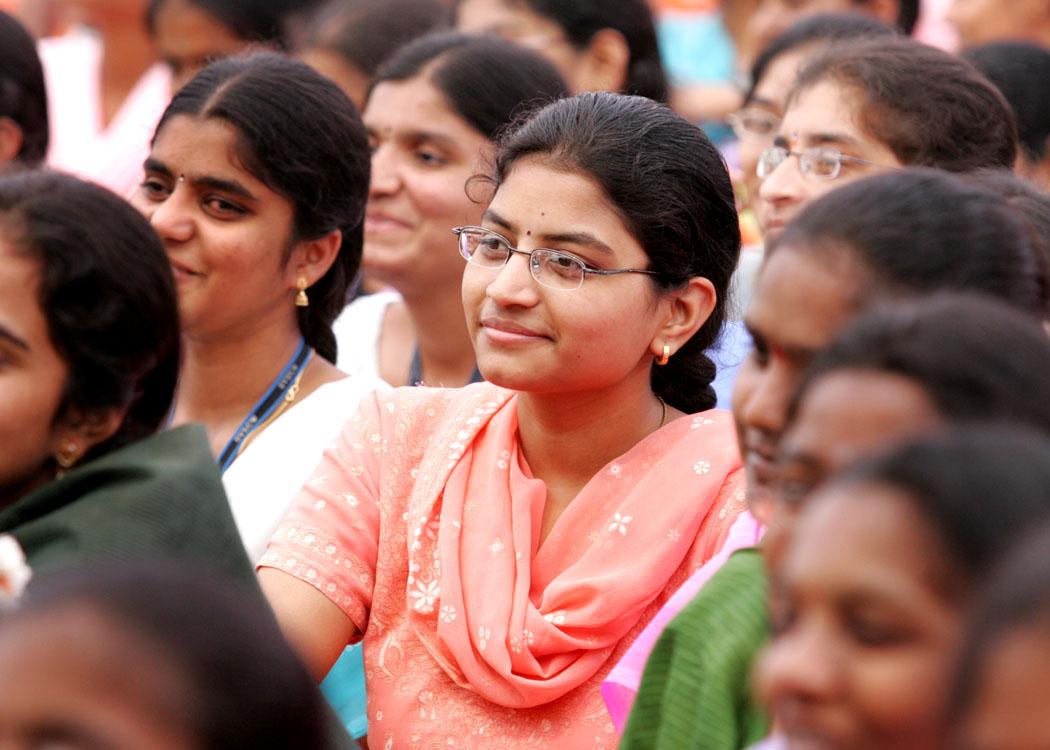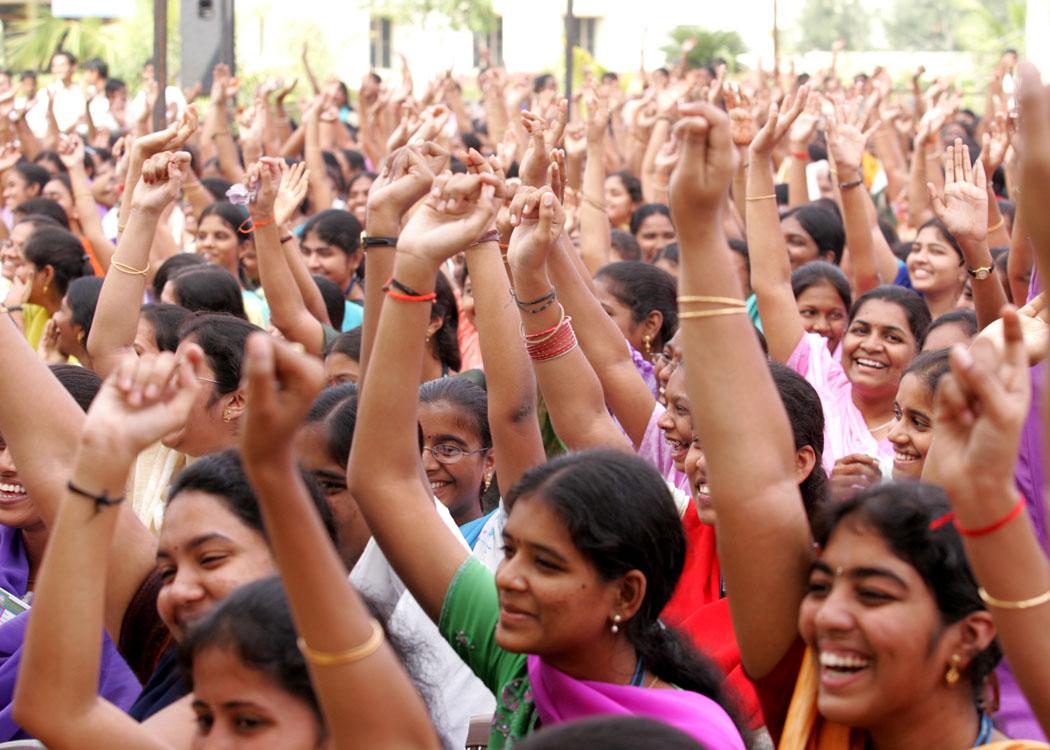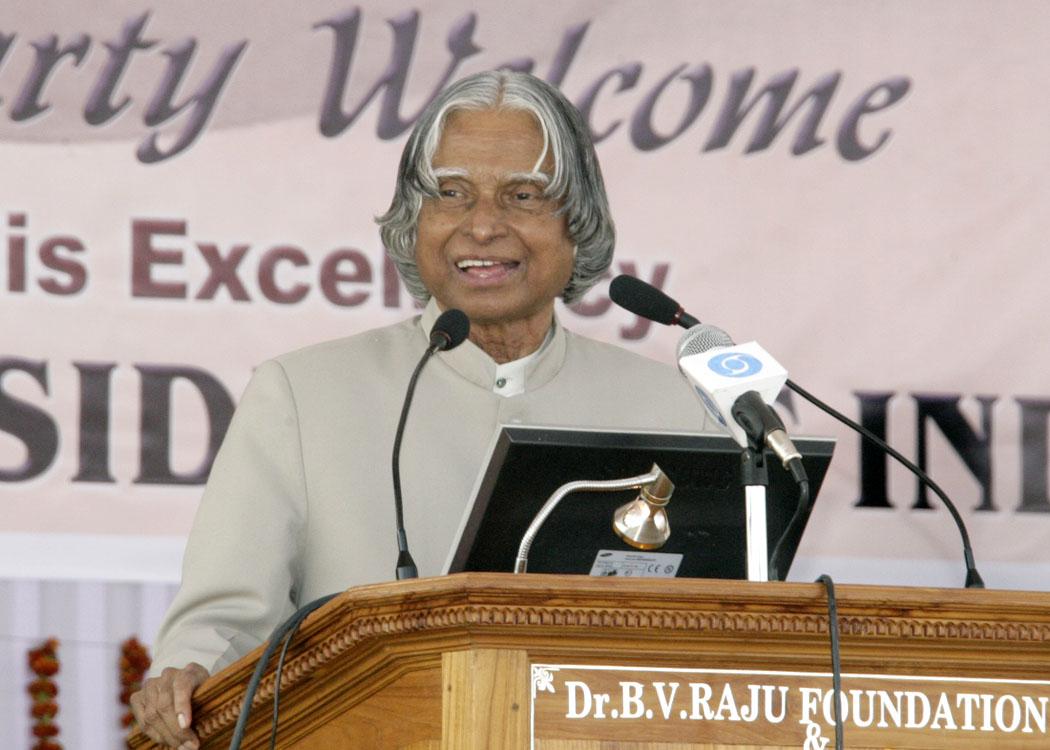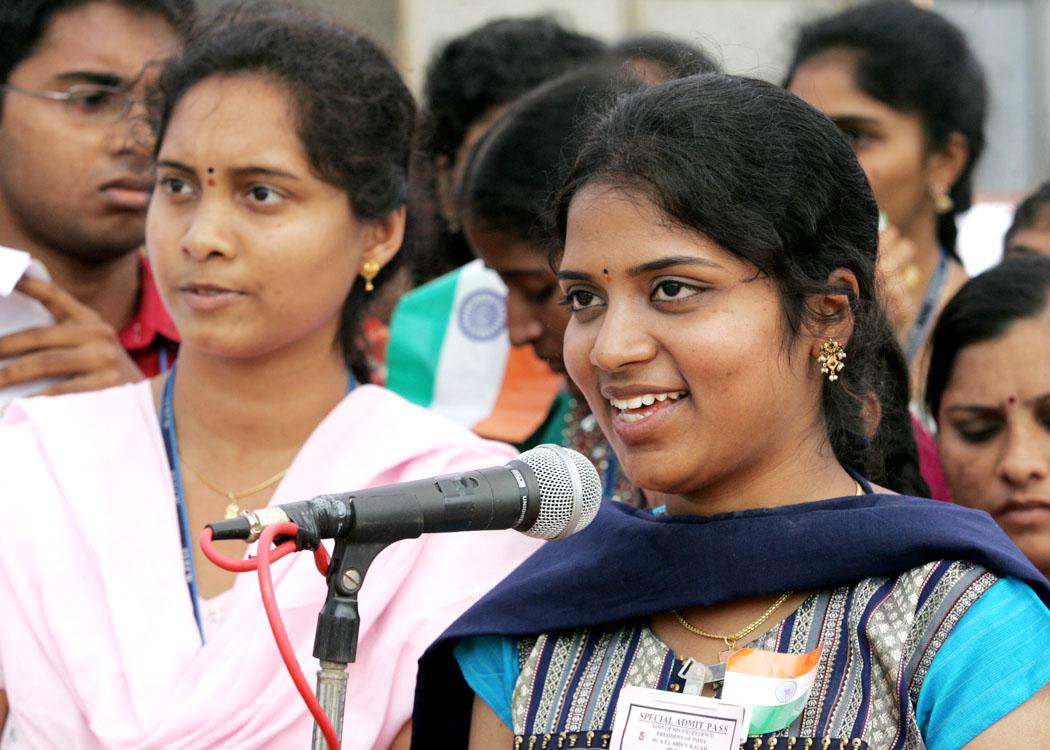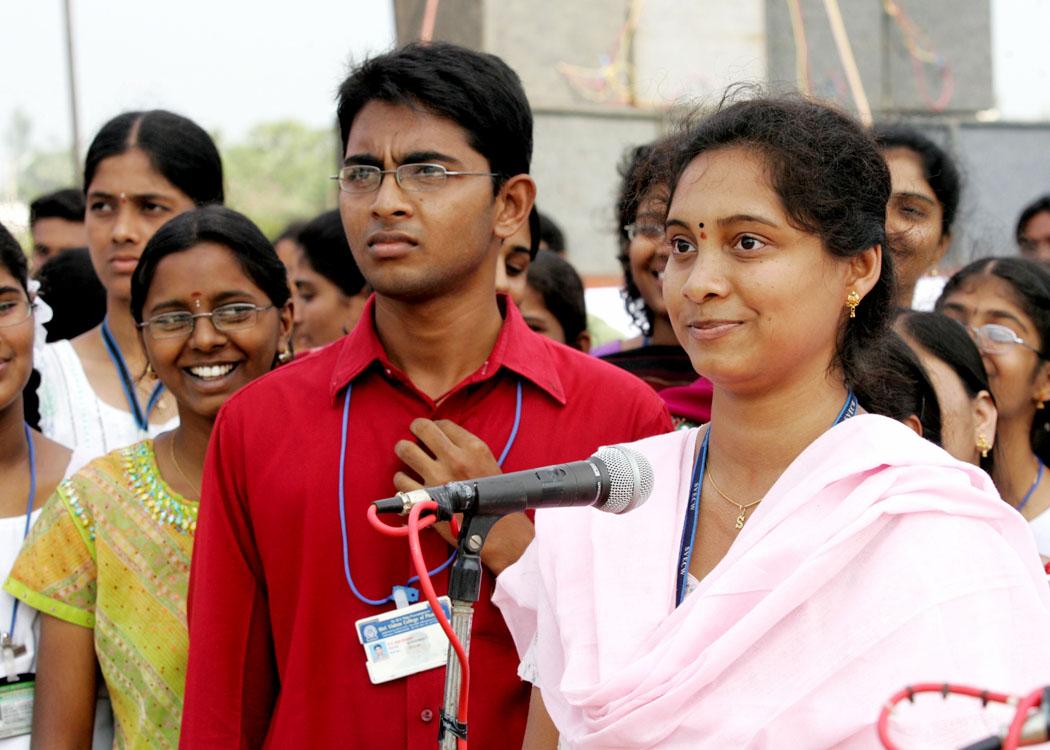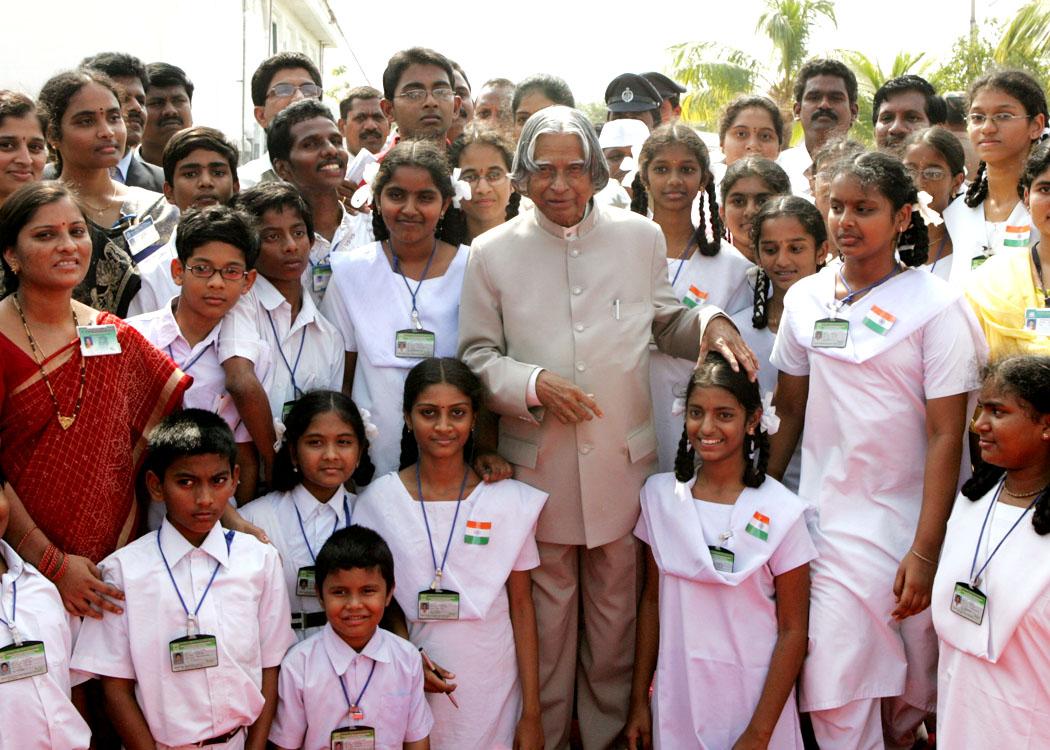Address And Interaction With The Student At Sri Vishnu Educational Society, Bhimavaram
Bhimavaram, Andhra Pradesh : 09-01-2006
Technological Institutions Can Lead to Integrated Rural Development
I am delighted to participate and interact with the students, teachers, and parents of the Sri Vishnu Educational Society. When I am in the midst of the students and teachers, I would like to congratulate Shri K.V. Vishnu Raju and his team for carrying forward the noble pioneering work done by Dr. B.V. Raju in establishing and nurturing this profound educational complex in Bhimavaram supported by other societal activities such as health care, housing, hygiene and water supply. I had personally met Dr. B.V. Raju at Hyderabad and we had discussed many issues regarding the development of Bhimavaram region. I would like to share some important events in the life of two scientists which can enrich the work of aspiring students in their pursuit of science as a life time mission.
Madam Curie - a dream for every women scientist
Madame Curie was born in Warsaw, Poland in 1867. Her parents were teachers, and she learned at an early age the importance of education. Her mother died when she was young. Her father was punished for teaching Polish - which had been made illegal under the then Soviet government. Manya, as she was called, and her sisters were forced to look for jobs for their living. After a couple of failed attempts, Manya became a tutor to a family in the countryside outside Warsaw. She enjoyed her time there, and was able to send her father money to support him, and also send some money to her sister Bronya in Paris who was studying medicine. Bronya eventually married another medical student and they set up practice in Paris. The couple invited Manya to live with them and study at the Sorbonne - a famous Parisian University. In order to fit in better at the school, Manya changed her name to the French "Marie." Marie studied physics and mathematics and quickly received her masters' degrees in both subjects. She remained in Paris after graduation and started research on magnetism.
For the research she wanted to do, she needed more space than her small lab. A friend introduced her to another young scientist, Pierre Curie, who had some extra room. Not only did Marie move her equipment into his lab, Marie and Pierre fell in love and married. A friend of the Curies, A. Henri Becquerel, had been playing with recently discovered properties of the element uranium. He talked to Pierre and Marie about those properties and they became interested in them too. Marie Curie set about investigating the effect, which she named "radio-activity" for her Doctorate research.
Marie Curie checked many other elements to determine whether they too were radioactive. She found one, thorium, and also came across a source of radiation in a mixture called "pitch-blend," which was much more powerful than either thorium or uranium. Working together, it took Marie and Pierre four years to isolate the radioactive source in the pitch-blend. Marie named it radium. For the discovery of radium, Marie and Pierre won a Nobel Prize in Physics in 1903, which they shared with their friend A. Henri Becquerel. Shortly, Marie found that what she had discovered was not pure radium, but she was able to isolate the element itself after quite a struggle. For this work, she was given second time Nobel Prize. This time it was for Chemistry in 1911. The courage and perseverance shown by Madame Curie in her pursuit of scientific mission and achieving successes are indeed remarkable and stimulating. Now I would like to talk about Indian Space Visionary Prof Vikram Sarabhai.
Indian Space Visionary
Prof Vikram Sarabhai worked with Sri CV Raman in experimental cosmic ray. Prof Sarabhai established Physical Research Laboratory in Ahmedabad with Space research as focus. In later years he become the Director of Space S&T Centre. The SSTC (1963) started with launching sounding rockets for space atmospheric research. Prof. Vikram Sarabhai unfurled the space mission for India in 1970 that we should build Satellite Launch Vehicle capability, to put our communication satellites in the geo-synchronous orbit and remote sensing satellites in the polar orbit. Also, he envisaged that launch vehicles built in India should be launched from Indian soil. This one visionary thought led to intensive research in multiple fields of science and space technology. Many of us had the fortune to be part of Prof. Vikram Sarabhai's vision. Myself and my team participated in India's first satellite launch vehicle programme to put the satellite in the orbit. Today, India with her 20,000 scientific, technological and support staff in multiple space research centres, supported by about 300 industries and academic institutions, has the capability to build any type of satellite launch vehicle to place remote sensing, communication and meteorology satellites in different orbits and space application has become part of our daily life. Dear young friends, you have seen how scientists have worked with zeal, enthusiasm and perseverance to achieve their goal. I would like you to emulate these visionaries, dream and work for realizing excellence in your work and transforming India into a developed nation. Now I would like to discuss how Sri Vishnu Educational Society can become a nodal centre for development of PURA clusters in Bhimavaram region.
Mission for the 93rd Indian Science Congress
When I addressed the 93rd Indian Science Congress in Hyderabad on 5th January 2006, I suggested that the decision can be taken to allot Rs. 500 crore to develop 100 PURA Clusters and its components (comprising of 20 to 30 villages in the vicinity of the institution/college) by the 100 selected educational institutions or colleges spread across the country. Rs. 5 crore each will be utilized for developing infrastructure in rural complexes such electronic and knowledge connectivity to 100 clusters leading to setting up of village knowledge centres; agri-clinics; tele-education and tele-medicine centres; and other employment oriented schemes such as bio-gas plants; water treatment plants (brackish to potable water); mobile clinic with tele-medicine facility; initiating Jatropha farming to extraction plants; bio-fuel esterification plants; cold storage; consumer product development; vocational training centres and setting up of business centres by the entrepreneurs for national and international marketing of the products from these rural enterprises. In all these cases, the educational institutions should plan the activities in consultation with local people who are the beneficiaries of this programme.
These programmes initiated by 100 educational institutions colleges with public-private partnership will provide the experience to other institutions for taking up big programmes in future in an industrial scale. This venture will build the capacities of the villagers and encourage the Indian entrepreneurs to become an active partner in this development process. These activities should not be treated as mere experiments and scientific knowledge, it is the application of science and technology to societal transformation. The winners are the academic institutions and the rural people belonging to the PURA Clusters. At the end, there should be a clear assessment whether the users (villagers) have benefited by the villagers themselves. This can be assessed by a joint team of the village members and the scientists/technologists. This will lead to the birth of the Civic Scientists. This is the performance challenge for scientific and academic community and Government officials. This mission I gave since I had seen three operational PURAs one in Tamil Nadu, second in Maharashtra and the third in Madhya Pradesh. Let me discuss three successful models, Periyar PURA, Loni PURA and Chitrakoot. All the three are privately managed missions by academic institutions.
Periyar PURA (Tamil Nadu): I have inaugurated Periyar PURA complex pioneered by Periyar Maniammai College of Technology for Women, Vallam, Tanjore a year back. I thought of sharing with you the developmental concept of a cluster of over 65 villages near Vallam, Thanjavur district of Tamil Nadu that involves a population of 3 lakh. This PURA complex has all the three Connectivities - physical, electronic and knowledge - leading to economic connectivity. The center of activity emanates from the women engineering college that provides the electronic and knowledge connectivity. Periyar PURA has health care centers, primary to post graduate level education and vocational training centers. This has resulted in large-scale employment generation and creation of number of entrepreneurs with the active support of 850 self-help groups. Two hundreds acres of waste land has been developed into a cultivable land with innovative water management schemes such as contour ponds and water sheds for storing and irrigating the fields. All the villagers are busy in cultivation, planting Jatropha, herbal and medicinal plants, power generation using bio-mass, food processing and above all running marketing centres. This model has emanated independent of any government initiative. The committed leadership has been provided by the Engineering institution. Recently, 5 of Periyar PURA villages are connected through Wi-MAX Wireless and having min 4 mbps connectivity with the Periyar PURA Nodel centre. It provides a sustainable economic development in that region. This gives me the confidence that PURA is a realizable proposition and this movement can be multiplied by thousands of entrepreneurs, educational administrators, small-scale industrialists and bankers with the support of the government agencies.
PURA: Loni Model (Maharashtra): Recently, I visited a place called Loni in Maharashtra where a participative model of integrated rural development has come up among 44 villages with the population of 80 thousand. The Loni PURA model has been pioneered by Pravara Medical trust. It is improving the productivity of the rural people through improved quality of life with healthcare, education and employment. The concept is people centric development for social transformation. The thrust area of development has been on comprehensive Medicare particularly for women and children, need based health education and e-connectivity to the farmers. The complex has created 27 educational and vocational institutions consisting of schools, colleges, polytechnic and ITI including medical and engineering colleges. They have created sugar factory, biogas plants, chemical plants and power projects. They have large number of self-help groups for providing low interest loan for the weaker sections in the society. Due to the co-operative effort of the people, literacy in these villages has gone up from 63% to 83%, birth rate has come down, infant mortality rate has decreased to 35 per 1000 from 70 per 1000 and the standard of living of the people has gone up by over 20% compared to other villages in the neighbouring areas.
Chitrakoot PURA (Madhya Pradesh) : Recently I visited Chitrakoot in Madhya Pradesh, where I met Shri Nana Deshmukhji (Age 90) and his team members belonging to Deendayal Research Institute (DRI). DRI is a unique institution developing and implementing a village development model, which is most suited for India.
DRI understands that people's power is more potent, stable and enduring than political power. By becoming one with the oppressed and depressed, one gains the acumen of administration and governance. Social advancement and prosperity are possible only by injecting the spirit of self-reliance and excellence in the younger generation. Using this principle, DRI has plans to develop one hundred clusters of villages having approximately five villages each around Chitrakoot. They have already developed 80 villages in 16 clusters consisting of about 50,000 people.
I witnessed one of the villages called Patni where the institute has promoted sustainable development based on indigenous and traditional technology, knowledge systems and local talents. The research work by the institute through field studies facilitates the development of replicable and tangible model for achieving self-reliance in villages. The programme aims at income generation through value addition, innovative agricultural practices, inculcating scientific temper among the villagers, improvement of health and hygiene, striving towards 100% literacy. As a part of integrated rural development, the villagers are doing water harvesting; effectively use it for cultivation of food grains, medicinal and aromatic and horticulture cultivation. Apart from all these development activities, the institute is facilitating a cohesive conflict free society. As a result of this, I understand that the eighty villages around Chitrakoot are almost litigation free. The villagers have unanimously decided that no dispute will find its way to court. The differences will be sorted out amicably in the village itself. The reason given by Nana Deshmukhji is that if the people fight among each other they have no time for development. They can neither develop themselves nor the community. This message has been understood by the society and they have decided not to embark on any fighting. All these have been accomplished through DRIs "samaj-shil-pi dampati" (a graduate married couple) a new concept of counseling and intervention promoted by DRI. It was a great joy for me to take lunch with Patni village citizens. A new road connecting multiple villages in the Chitrakoot area is taking shape. In the same Chitrakoot environment there is another social organization called Shri Sadguru Seva Sangh trust is carrying out number of social activities including the running of quality eye care center. In a rural environment, I find a revolution is taking place due to the committed leadership to remove the human pain.
Analysis of the Present Scenario
Sri Vishnu Educational Society can study the models that I have suggested and assist in the mission of providing sustainable development in the villages situated in Bhimavaram mandal having fifty villages with a population of three lakh. The Engineering College with the strength of 1300 can become the nodal point for this development as in the case of Periyar PURA which I have described to you earlier. The focus will be to generate sustainable employment to the youth of the villages and improving the quality of life in the rural areas while preserving the Civilizational heritage of this area.
Conclusion
PURA (Providing Urban Amenities in Rural Areas) is a growth driver of our economy. Sri Vishnu Educational Society has an opportunity to put this concept into practice in all the 116 villages of Bhimavaram region by providing the human resource generated by the Trust. This programme will enrich the rural environment and can benefit nearly 5 lakh people of this region. This can become a model configuration for realizing 100% literacy, imparting quality employment skills to the youth, connectivity to all, creation of sustainable rural enterprises and empowering job creatures in the rural sector. If this can be accomplished in a time bound manner, it will definitely become a pace setter in sustainable development for Andhra Pradesh. Since a number of societal transformation establishments are functioning in Bhimavaram area, an integrated rural development programme of physical, electronic and knowledge connectivity will lead to economic connectivity. This is possible since the District Administration is already engaged in rural development tasks such as Akshara Vanitha and E-seva. I have seen such an integrated action taking place at Nagapatnam in Tamil Nadu. I am sure that this will enable faster, co-ordinated development of the Bhimavaram region and become a model for emulation by others.
My best wishes to the members of Sri Vishnu Educational Society for success in their mission of developing human resource for enhancing the rural prosperity in this region.
May God bless you.

